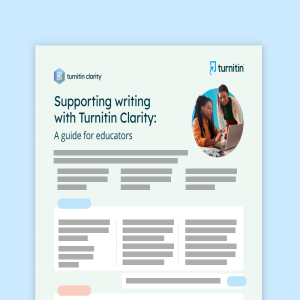In the United States, secondary school educators are the fastest adopters of AI platforms, leaning into new tools to support student engagement and AI literacy.
But to protect authentic student writing, many have found themselves returning to handwritten assignments – a time-consuming safeguard from the analog era.
As a former educator myself, I’m here to tell you there is another way.
Applying the familiar ‘show your work’ approach from STEM subjects to student writing offers a way forward, one that many educators have already adopted.
It provides a much-needed window into the workings of the student mind at a time when GenAI can bypass authentic cognition and composition. However, it isn’t always the most time-efficient process.
Fortunately, new technology is rising to that challenge, helping educators protect both authentic student writing AND their precious teaching time. Let’s dig deeper…
What is the ‘show your work’ concept, and why is it pedagogically valuable?
Any math teacher can tell you that the ‘show your work’ approach isn’t about students answering a question, it’s about showing how they arrived at their answer.
This provides invaluable insights into students’ knowledge of the topic, techniques, and any gaps in their learning – information that would be hidden if not for them showing their work.
However, this approach isn’t just beneficial in math and sciences. The concept of shining a light on students’ approach to their subject is universally valuable.
What the ‘show your work’ approach involves
Many humanities teachers already apply the ‘show your work’ approach to the student writing process. Assignments require process artefacts – such as outlines, drafts, and revision logs – that provide visibility into how students think, plan, structure an argument, and use sources.
This allows educators to identify areas for improvement and provide personalized feedback to support students’ future work.
Increased transparency is particularly important in the so-called ‘Intelligence Age’, where AI-powered tools are prevalent and students may rely too heavily on Generative AI in their writing process.
Why the ‘show your work’ approach is challenging to implement
The ‘show your work’ approach to written assignments can be time-consuming – requiring rounds of formative feedback at each stage – and many educators are concerned about the impact on their already heavy workloads if they use it more often.
Don’t worry, we’ll get on to the solution soon. First, let’s look at what the experts say about AI in the student writing process. Because it isn’t all bad. It’s about how it is integrated.
How has AI changed the student writing process?
AI can benefit or bypass learning, depending on how it is used within the student writing process.
Pros of AI in student writing
On one hand, tools like Grammarly, WordTune, and QuillBot can help learners strengthen grammar and develop their writing skills independently (Yeo, 2023).
Plus, AI’s interactive interface and real-time responses support immersive learning experiences and help students understand complex concepts (Lim et al., 2023).
And, of course, using AI helps students prepare for the AI-ready workforce of the near future.
Cons of AI in student writing
On the other hand, GenAI can be used to create entire assignments with minimal or no student input, something 26% of students admitted to in 2025 (HEPI).
This prompt-and-paste approach denies the student the opportunity to develop critical thinking and composition skills and to deepen their subject knowledge.
In turn, there are concerns that this may ‘hinder people’s growth, skills, and intellectual development over time’ (Chan and Hu, 2023).
On balance, education leaders are leaning into AI as a tool to enhance learning and employability – but with appropriate safeguards to protect authentic knowledge and skill development.
How are schools responding to AI in student writing? Insights from the United States
US schools are responding to AI in student writing by redesigning their assessments to reduce the risk of student misconduct and missteps.
Designing assignments that require process documentation and iterative development – ‘show your work’ – is one approach. Other educators have found themselves reverting to more traditional assignments, using handwritten work and oral presentations.
While these approaches may be effective in reducing access to AI tools, they can create other issues for students and teachers.
- Limiting the timeliness of educator feedback (which is key, given 2025 research found a significant drop in student motivation and perceived usefulness of feedback when response time exceeds 10 days)
- Significantly impacting teachers’ assessment and grading workload, with K-12 workers already experiencing high levels of burnout (Gallup)
- Adding to ‘AI fatigue’, the sense of overwhelm caused by constant vigilance and authenticity checks perceived to be needed in the age of AI
This pre-digital approach to assignments also undermines US secondary schools’ otherwise AI-forward approach to integrating new technology and developing student AI literacy.
According to national research, 60% of K-12 teachers used AI tools during the 2024-2025 school year, with high school and early-career teachers even more likely to use AI tools (at 66% and 69%, respectively).
Year-over-year adoption of AI tools has increased, with a notable 18% increase in teachers who recently started using GenAI prior to this semester/school year. This suggests that secondary education is experiencing the fastest growth rate in AI adoption.
In this context, reverting to handwritten assignments to reduce student AI use feels not just inefficient but also counterintuitive – especially as AI skills are the fastest-growing skill in demand with employers in 2025 (World Economic Forum).
So, what’s the answer? Many institutions are experimenting with different ways to design writing assignments for the age of AI. In parallel, edtech software partners are also working on solutions to address the challenge.
How does a ‘show your work’ approach enhance learning in the AI era?
In the AI era, the student writing process is just as important as the final product; if not more so.
Writing isn’t just a process of conveying what a student has learned, but is a learning process in its own right (Klein and Boscolo, 2016). This means authentic authorship must be protected, even as AI tools are integrated into teaching and learning processes.
Recent research shows that visibility into the student writing process enhances achievement and reinforces academic integrity, particularly in relation to GenAI tools (Rasul et al, 2024). Here’s why…
Nurturing authentic skill development
Understanding how students compose their written work lets educators nurture the skills AI can’t replicate, like critical engagement, problem-solving, and reflective thinking over time.
Studies show that metacognitive writing strategies – such as process reflections – boost learning outcomes. By thinking about their process, students and tutors can identify learning habits that lead to higher-quality work (Klein and Boscolo, 2016).
Providing formative feedback
Requiring process artefacts – like planning notes and assignment drafts – allows tutors to provide formative feedback.
This helps shape students reflect on their approach and refine their work prior to final submission. Research suggests that this approach helps instructors identify misconceptions early and tailor feedback more effectively (Kaufhold, 2025).
Shaping AI literacy and ethics
Asking students to disclose any AI used in their process can support AI literacy, shape ethical AI integration, and address instances that stray towards academic misconduct.
AI disclosure is a growing requirement in many academic institutions, particularly in higher education. Instead of asking ‘Did AI write this?’, it is about understanding ‘How did the student use AI? And did that use support their learning rather than undermine it?’
How can educators implement a ‘show your work’ approach to student writing?
To successfully implement a ‘show your work’ approach to student writing, educators can use a combination of evergreen best practices and new digital tools.
Apply writing process best practices
Follow the writing process consistently from pre-writing to publishing, with stops along the way for revision. These best practices have long led to better writing, and the process is more important than ever in the age of AI. Incorporate process checkpoints such as drafts, annotations, or AI usage logs.
Support students to develop AI literacy
Model the metacognition involved in how a writer decides how and when to use AI tools, so that students can integrate it effectively into their workflows. Show students how to critically evaluate AI outputs, as they would any other source. And ask for short reflections where students explain how they planned, revised, or used AI tools.
Use the right tools to make the process manageable
Select tools that support both teaching and learning throughout the writing process. Adopt process-based rubrics that reward effort, reflection, and revision, not just the final product. Plus, use digital tools to reduce the time burden often associated with a ‘show your work’ approach – such as controlled composition spaces that provide an audit trail of the writing process and identify potential overreliance on AI.
Together, these strategies:
- Enhance visibility into the student writing process and support higher attainment
- Protect student-teacher relationships by shifting from AI policing to AI guidance
- Strengthen academic integrity, without adding to ‘AI fatigue’
- Accelerate grading and feedback processes, benefitting both educators and students
Educators get clarity into student writing with Turnitin
Given the benefits of implementing a ‘show your work approach’, especially when supported by appropriate digital tools, it’s no surprise that AI-savvy secondary schools are adopting new solutions from Turnitin – namely Turnitin Clarity.
Turnitin Clarity provides students with a controlled digital composition space – similar to Microsoft Word or Google Docs – to complete their assignments. Students benefit from a familiar writing platform, while educators gain behind-the-scenes insights that show how an assignment was composed.
In the first 60 days after launch, nearly 100 US secondary schools have signed up to use this new feature – a clear sign that institutions are serious about building AI literacy while protecting academic integrity.
Having spent many years teaching high school English, developing curriculum and assessments, and leading educators, I know that this work is not easy. Taking a writing process approach, including elements of a “show your work” approach, takes a great deal of instructional time, and there is a significant burden on the teacher to review all those pieces along the way and provide formative feedback. But it works.
The positive impact of the writing process on helping students become strong, confident writers is well documented; with the addition of using digital tools like Turnitin Clarity to allow students to show their work, it becomes possible to manage that workload while also ensuring students don’t outsource their work OR their critical thinking.
Students need opportunities to practice using generative AI tools effectively and ethically, and educators need to have insight into how they are using those tools in order to safeguard integrity. Those can seem like polar opposite needs, but with this tool, they can actually be harmonious.
Turnitin Clarity is available as a paid add-on to Turnitin Feedback Studio customers.






